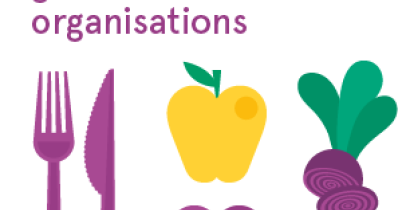Food Pyramids, Plates and Guides: Building a Balanced Diet
Last Updated : 14 January 2020Most European countries have developed food-based dietary guidelines (FBDGs), or, simply, healthy food recommendations, for their populations. They provide “advice on foods, food groups and dietary patterns to provide the required nutrients to the general public to promote overall health and prevent chronic diseases”. 1 Some countries provide a graphic representation, such as a food pyramid or a plate, to illustrate and sum-up the advice. As the food pyramid is one of the most common and hence most familiar graphic representations, it is used as an example throughout this article. To make it simpler, healthy food guides are used as an umbrella term for FBDGs.
Old and new food pyramids
The original food pyramid was created in Sweden in 1974. 2, 3 Other food advice had been presented earlier to the public, both in Sweden and elsewhere, but often as text or as a food circle. This first pyramid, which both grouped different types of food and showed the relative proportions in which they should be consumed, gained national and international attention. It was praised as easily understandable by everyone, including people with a low literacy.
Today, 90 countries worldwide have developed food-based dietary guidelines, or healthy food guides, for their populations. Some messages are nearly universal, such as consuming a variety of foods (including ample amounts of fruits and vegetables and water as the beverage of choice) and limiting intake of sugar, fat and salt. 4 There are, however, some variations from country to country, as the guidelines are adapted to local situations. 1 For example, in the Middle Eastern countries, legumes (like chickpeas and lentils) are commonly given in a food group of their own as they are a culturally important part of the diet in this region. 4 Some Mediterranean countries, such as Croatia, Cyprus, Greece and Spain, highlight the importance of choosing olive oil in the diet. 5, 6, 7, 8
Traditionally, advice was only given on food consumption, but some have evolved to also include advice on food safety and lifestyle (e.g. physical activity or social settings). More recently, many countries have added advice on sustainability, where they advise choosing local and seasonal, or otherwise sustainably sourced foods (Table 1).
Table 1: Food safety, lifestyle and sustainability messages in the food-based dietary guidelines of different EU countries.
|
Theme |
Country |
Examples from food-based dietary guidelines |
|
Food safety |
Slovenia 9 |
Prepare food in a safe and hygienic way. |
|
Italy 10 |
Hands must be washed thoroughly before cooking and touching foods to be eaten raw or that do not need further cooking, especially when switching from the processing of one food to another. |
|
|
Lifestyle |
Sweden 11 |
More exercise - Exercise for at least 30 minutes every day! Take brisk walks, for example, and reduce the amount of time you sit still by taking brief, active breaks. |
|
Belgium 12 |
Eat at set times and together with others. Eat consciously and with moderation. |
|
|
Sustainability |
Sweden 11 |
Economising on the Earth’s resources will ensure we have good food to eat in the future. That’s why we’ve devised this advice on how you can eat sustainably – to the benefit of both your health and the environment. So that you don’t have to choose. Examples: High fibre vegetables are an eco-friendly choice. Choose sustainable fish. (…) look out for ecolabels. Cereals have relatively small climate impact. |
Building a balanced diet
Food pyramids are developed to help people build a balanced and varied diet by following the food groups (levels of the pyramid) and consuming them in the right proportions (the size of the levels, from bottom to top). In practice, a balanced diet means that we should eat a variety of foods, in different proportions, and in general avoid leaving out entire food groups, as each food group provides fuel and nutrients required for optimal health. There are some differences in how foods are grouped from country to country.
The main food groups
Most dietary guidelines group foods into different categories, such as fruits and vegetables, grains and starches, protein rich foods, dairy foods, fats and oils, and foods to be limited. Each food group will provide different proportions of carbohydrates, fats and proteins. These so-called macronutrients are the main building blocks of our diet. Macronutrients provide energy and allow for normal growth and development. Different food groups contain varying amounts of macronutrients, but usually one or two dominate. For example, potatoes contain mostly carbohydrates, meat contains both proteins and fat, and beans contain carbohydrates and proteins. This composition also determines which food group food will belong to. In addition to the macronutrients, each food group will provide different proportions of vitamins and minerals, also called micronutrients, which are required in much smaller amounts and which support the proper functioning of our bodies. By consuming foods from all levels in the pyramid, we get all the important nutrients our bodies need. For example, dairy products can help provide calcium to support bone health, and consuming enough fruits and vegetables will supply vitamin C to support a healthy immune system. Excluding certain food groups from the diet increases the risk of getting too little or too much of some macronutrients, but also too little of the wide range of vitamins and minerals essential for healthy living. Additionally, it is crucial to think about portion sizes to avoid over- or undereating.
Some people have allergies or intolerances that necessitate exclusion of some products from the diet, whilst others (like vegans and vegetarians) choose to leave out certain products. In these cases, people should seek out alternatives that provide the same nutrients. Examples include fortified soya or nut drinks in place of dairy milk.
Examples of balanced meals
So, where to start? Look up the dietary guidelines of your country and have them in mind when planning your meals and grocery shopping. Here, we will use the Irish food pyramid as an example. This example meal plan is aimed at the general population, so portion sizes and nutrient needs will vary depending on age, gender, activity level, pregnancy or breastfeeding, and health status.
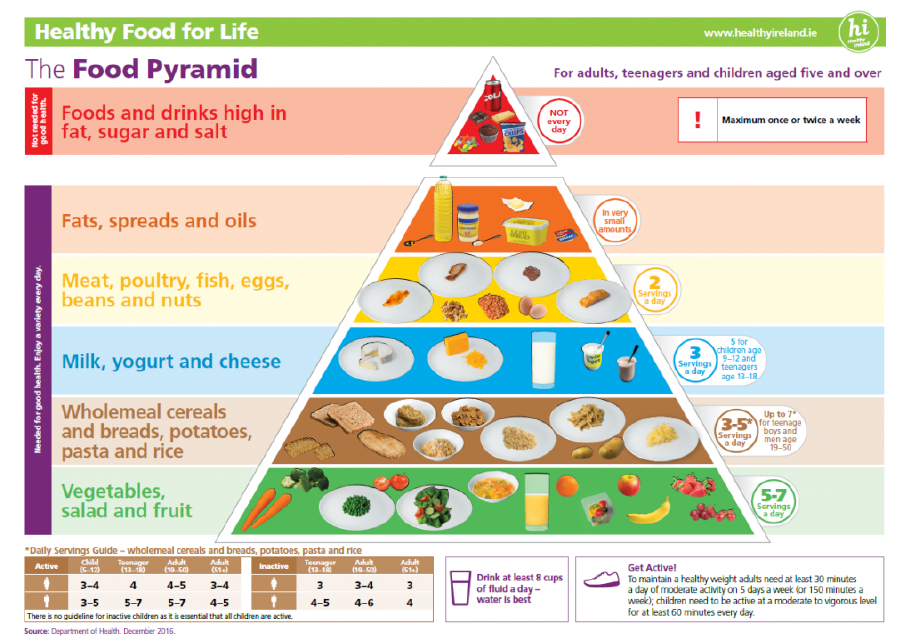
Figure 1: Example of Irish food pyramid, with levels 1-6 from bottom to top. 13
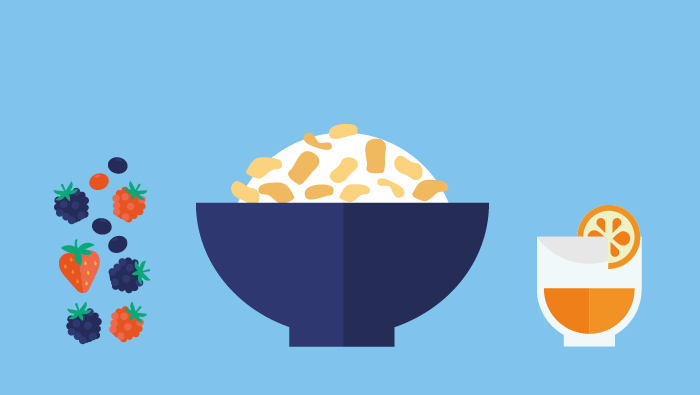
For breakfast, the first meal of the day:
- Start by choosing something from the two bottom levels of the food pyramid: i.e. vegetables, salad and fruit (level 1) and wholegrain cereals and breads, potatoes, pasta and rice (level 2). This could be achieved by, for example, a bowl of oatmeal with apple slices. Then add smaller amounts of foods from other levels, for example by topping the oatmeal with low-fat cottage cheese (level 3) or almonds (level 4).
- A quicker breakfast could be unsweetened, wholegrain cereal (level 2) with low-fat milk (level 3) and a glass of orange juice (level 1, but only one glass of 150 mL a day), which could also be topped with fruit or berries (level 1) or nuts (level 4).
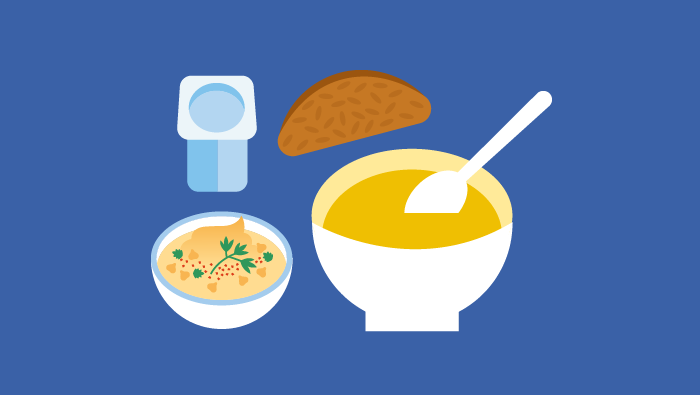
A balanced lunch could be a vegetable soup (level 1) with wholegrain crispbread (level 2) and some hummus made with chickpeas (level 4) and vegetable oil (level 5) and a yoghurt (level 3).
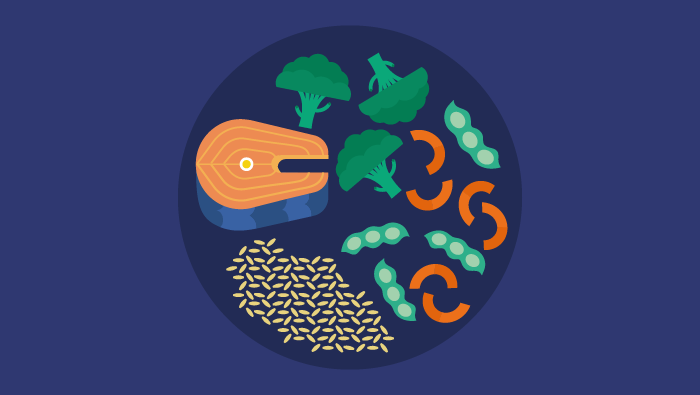
A balanced dinner could be a tasty stir-fry made with vegetables (level 1), fish, chicken filet or tofu (level 4) and low-salt soy sauce. How about changing the normal white rice and serve the stir-fry with fibre-rich brown or wholegrain rice instead (level 2)?
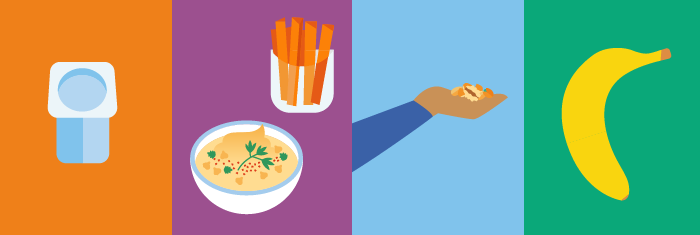
Snacks can be eaten between meals, for example, a banana (level 1), a closed handful of nuts (level 4), carrot sticks with hummus (level 1 & 4), an apple with a touch of peanut butter (level 1 & 4) or a yoghurt (level 3).
However, not all meals have to be perfectly proportioned. We should aim for balance over a day or a week. If lunch one day contains a lot of grains and cereals, then dinner could contain more protein. And, when aiming for balance over a period of time, there is also room for an occasional treat.
Food pyramid for kids
Existing food pyramids represent healthy diets for populations in general, sometimes with adjustments for people in specific conditions, life-stages or circumstances (e.g. pregnant and breast-feeding women, or elderly). Children have slightly different nutritional needs to adults, but healthy food guides usually apply for children from 2 years of age and older. 4 Still, portion sizes need to be adjusted for children, but always keeping in mind their activity level and growth. Generally, children are advised to be more physically active than adults (Table 2).
Table 2: Advice on physical activity for children from the food-based dietary guidelines.
|
Country |
Advice (excerpts) on physical activity for children |
Advice (excerpts) on physical activity for adults |
|
Norway 14 |
At least 60 minutes of moderate to high intensity physical activity every day. At least 3 times a week should activity that increases muscular strength and strengthens the skeleton be included. |
Adults should be physically active at least 150 minutes of moderate intensity per week or a minimum 75 minutes of high intensity per week. Exercises that give increased muscular strength to the big muscle groups should be performed twice or more per week. |
|
Ireland 15 |
All children and young people (2-18) should be active, at a moderate to vigorous level, for at least 60 minutes every day. |
Adults (18-64): at least 30 minutes a day of moderate activity on 5 days a week or 150 minutes a week. |
Food pyramid for vegetarians and vegans
Similarly to healthy food guides for children, there are no official guides specifically for people who choose to eat vegetarian or vegan. However, more plant-based diets are gaining popularity, and balanced diets can be adjusted accordingly. Careful planning might be required to ensure the diet provides the right nutrition. For example, vegans and some vegetarians need to think carefully about getting enough vitamin D, vitamin B12, calcium, iron, zinc and omega-3 fatty acids, in addition to high quality protein. It is also important to know that iron from plant-based foods is not as well absorbed as (haem) iron from animal-based foods. While many plant-based foods such as tofu, lentils and chickpeas can be rich in iron, this iron is not as well absorbed as iron from animal-based foods. One way to improve the absorption of iron from these foods is to consume them with foods rich in vitamin C, such as orange juice, which can help improve iron absorption from plant-based sources.
For those on a vegan diet, it can be very difficult to get enough vitamin B12 from dietary sources as this vitamin is only naturally present in animal-based foods. It can also be found in fortified foods and yeast extracts, but these sources may not always be available. For this reason, it may be necessary to take vitamin B12 supplements to ensure an adequate intake.
Healthy food guides for people with diabetes
In general, people with type 1 and type 2 diabetes are also advised to follow the dietary guidelines for a healthy and balanced diet. As for the rest of the population, this means that starchy vegetables, wholegrain products and fruit should be the main sources of carbohydrates, and the consumption of added sugar, saturated fat and salt should be limited. In addition to medication, spreading carbohydrate intakes across the day and staying active may help keep blood sugar stable. 16, 17 For people with diabetes it is recommended to consult a registered dietitian or general practitioner before making significant dietary changes.
Conclusion
Food pyramids and healthy eating guidelines are made to represent a healthy diet for the population in general. We should adjust them by choosing the right amounts of preferred foods within each food group to fit our individual health, lifestyle, life-stage and preferences. Aiming for balanced meals and a variation of foods within each level of the pyramid is beneficial for optimal health. Physical activity is equally important for living a balanced and healthy life.
References
- FAO, "FAO," [Online].
- Coop, "Ett provkok blev ett provkök," [Online].
- "Nutrition Australia: A brief history of the Pyramid," [Online].
- H. e. al., "A Global Review of Food-Based Dietary Guidelines".
- "Croatia," [Online].
- "Cyprus," [Online].
- "Greece," [Online].
- "Spain," [Online].
- "Slovenia," [Online].
- "Italy, page 89-90," [Online].
- "Sweden," [Online].
- "Belgium," [Online].
- "Ireland Pyramid," [Online].
- Helsedirektoratet, "Anbefalinger om kosthold og ernaering og fysisk aktivitet".
- I. p. activity. [Online].
- Diabetesforbundet. [Online].
- Diabetesforbundet. [Online].
- FAO/France. [Online].

